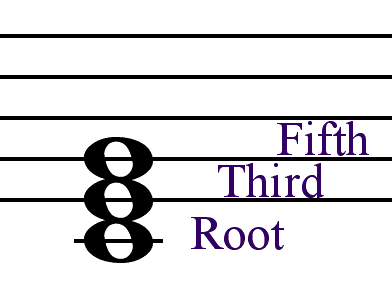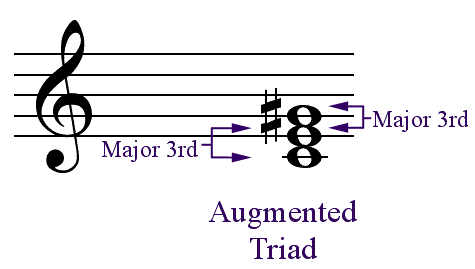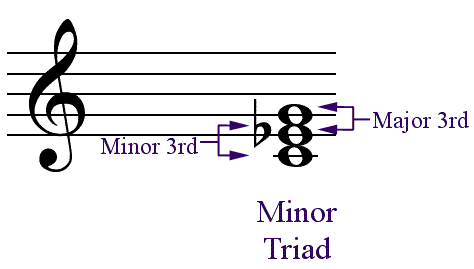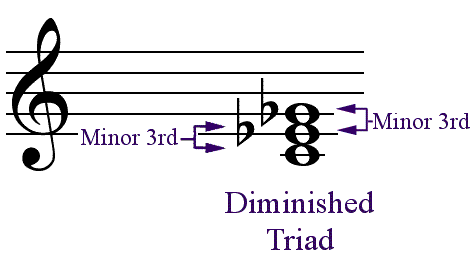Triads
|
||||||||||||||
|
Contents |
|
![]()
Definition of Triad
A triad is a chord that is made from a combination of three notes that are typically the root, third, and fifth. When in root position these notes form two superimposed thirds. (e.g. C-E-G is the root position of a common C Major Triad).
The terms root, third and fifth come from the scale degrees that the triad is based on. For intance, if you take a look at example below, you will see the C major scale with the scale degrees listed under each note. The root is the fundamental pitch that the scale begins on.

Root Position
When you stack the root, third and fifth of the scale vertically in any order, what you get is a triad. Whenever you have a triad that has the root as the lowest pitch (as in bottom note), then what you have is a triad that is in root position.

![]()
Definition of Chords
Chords have a broader definition than triads. Chords must have at least three notes to be called a chord but often have more notes. For instance a G13 chord can have seven notes. However a triad only has three notes.
![]()
Spelling Triads
All triads are spelled with a combination of three specific note letters. For instance, all C triads are spelled with a C an E and a G. These notes can be sharp or flat but if the triad is to be in the family of C triads, it must have those three letter names.
There are basically seven spellings for triads and they are listed in the following example. Memorizing these groupings will benefit your ability to play all chords!

![]()
There are Four Types of Triads (Quality)
As mentioned above, triads in root position are comprised of two thirds. The two types of thirds that we use to construct triads are the Major Third and the Minor Third (See Intervals and Interval Chart). The quality of a triad is determined by what combination of thirds we are using.
For instance if a triad has a major third on the bottom and a minor third on the top, we have a major triad. The following table offers the four basic triads with the necessary combinations of thirds needed. Keep in mind that all four triads can begin on any of the 12 notes and their enharmonic spellings.
The Four Triads
(Given in root position with 'C' as Root)
Augmented Triad
|
 |
Major Triad
|
 |
Minor Triad
|
 |
Diminished Triad
|
 |
Play each triad and listen carefully for the differences!
also
Moving from any triad, up or down on this chart,
to an adjacent triad
involves moving only one note!
![]()
The Four Triads Can Have Any Root Note
As mentioned above, triads can have different root than C. In the following example there are seven major triads that begin on the unaltered keys of the piano (white notes). In order to keep the major sound of each chord, it is necessary to raise certain notes (#) to keep the major 3rd/minor 3rd relationship necessary for major chords. Play the first example given at the top of this page and listen to each chord. Now play the following example.

In the above example each triad is major. It also may be said that the root of each triad indicates it's name. Hence we have C Major, D Major, E Major, F Major, G Major, A Major, and B Major triads. (You can also say chords rather than triads.) It is also possible to move chromatically to discover all possible major triads.
In the next example we explore the minor triad as formed, once again, on each of the unaltered notes of the keyboard. Each triad below has a minor 3rd on the bottom and a major 3rd on the top. The first triad is the C minor triad. Play this triad and listen. Compare this triad with the C major triad. Can you tell the difference of the way they sound with your eyes closed?
Now play each minor chord listed below. Once again, in order to maintain the minor 3rd/ major 3rd relationship, certain notes needed to be altered. Also the root of each triad indicates the name so now we consecutively have:

C minor, D minor, E minor, F minor, G minor, A minor and B minor triads.
![]()
Triad Inversion
Triads need not be only in root position. Triads can also be rearranged into inversions. Triads can in fact be commonly found in root position, 1st inversion, and 2nd inversion. Triad inversions are named like this:
-
Whenever the root of the triad is in the bass (bass refers to the lowest note in this case),
then that triad is said to be in root position. -
Whenever the third of the triad is in the bass, then that triad is said tro be in 1st Inversion.
-
Whenever a triad has the fifth in the bass, that triad is said to be in 2nd Inversion.

As always, play each example and listen to the differences. You will probably notice that the root position triad sounds more final than the two inverted triads. This is because the root position triad is the most stable in terms of musical tension. Musical tension is largely why music is interesting. The contrast between tension and release is what makes music work. The inverted triads are not completely at rest ad so indicate some amount of tension. All the triads, in all keys, can be inverted in this way.
This concludes this lesson. There is still
much to be learned about chords, and inversions.
I will be posting further articles that will cover this essential
part of your music understanding.
If you have any questions, contact me and I will be glad to help.